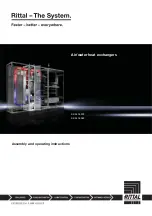
Rittal air/water heat exchanger
11
4 Installation
EN
The units do not have any separate ventilation. They may
be vented using the water connections on the top of the
device (either manually or by installing suitable vent de-
vices).
4.4.1
Notes on water quality
To ensure the reliable operation of the above-mentioned
units, the VBG guidelines for cooling water must be ob-
served (VGB R 455 P).
The cooling water must not contain any limescale de-
posits; in other words, it should have a low level of hard-
ness, in particular, a low level of calcium hardness. In
particular, for recooling within the plant, the calcium
hardness should not be too high. On the other hand, the
water should not be so soft that it attacks the materials.
When recooling the cooling water, the salt content
should not be allowed to increase excessively due to the
evaporation of large quantities of water, since electrical
conductivity increases as the concentration of dissolved
substances rises, and the water thereby becomes more
corrosive.
Always add the appropriate volume of fresh water.
Always remove part of the enriched water.
The following criteria for the cooling water must be ob-
served:
– Water with high gypsum content is unsuitable for cool-
ing purposes because it has a tendency to form boiler
scale that is particularly difficult to remove.
– The cooling water should be free from iron and man-
ganese, otherwise deposits may occur that accumu-
late in the pipes and block them.
– At best, organic substances should only be present in
small quantities, otherwise sludge deposits and micro-
biological contamination may occur.
4.4.2
Preparation and maintenance of the water
in recooling systems
Depending on the type of installation to be cooled, cer-
tain requirements are placed on the cooling water with
respect to purity. According to the level of contamination
and the size and design of the recooling systems, a suit-
able process is used to prepare and/or maintain the wa-
ter.
The most common types of contamination and most fre-
quently used techniques to eliminate them in industrial
cooling are:
4.5
Routing busbars
Busbars and cables may be routed through the unit at
the top or bottom.
Routing at the top
Fig. 11:
Routing at the top
Note:
The water circuit should be protected from
ingress of dirt or excess pressure (maximum
permitted operating pressure 10 bar)!
Note:
Volumetric flows >3,000 l/h may cause dam-
age to the device. Suitable measures should
be taken to regulate the volumetric flow, such
as flow regulator valves. Damage caused by
excessive volumetric flows will not be cov-
ered by Rittal's warranty.
Note:
No increase in cooling output is achieved
with flow rates >3,000 l/h.
Note:
Observe the flow direction and check for
leaks!
Contamination of the
water
Procedure
Mechanical contamination
Filter the water using:
– Mesh filter
– Gravel filter
– Cartridge filter
– Precoated filter
Excessive hardness
Water softening via ion ex-
change
Moderate content of me-
chanical contaminants and
hardeners
Addition of stabilisers and/
or dispersing agents to the
water
Moderate content of chemi-
cal contaminants
Addition of passifiers and/or
inhibitors to the water
Biological contaminants,
slime bacteria and algae
Addition of biocides to the
water
Tab. 2:
Contamination and procedures for eliminating it


























